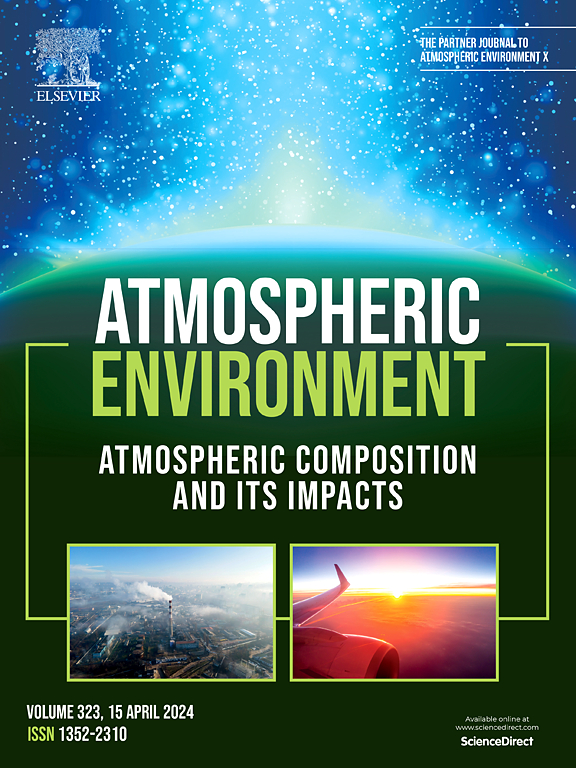Vertical distribution and regional transport of air pollution over Northeast China: Insights from an intensive aircraft study
IF 3.7
2区 环境科学与生态学
Q2 ENVIRONMENTAL SCIENCES
引用次数: 0
Abstract
We report an intensive aircraft study of regional air pollution over Northeast China during July and August 2018, unraveling the vertical distributions and regional transport of a variety of trace gases and aerosols. Major air pollutants, including sulfur dioxide (SO2), nitric oxide (NO), ozone (O3), black carbon (BC), aerosol scattering coefficient (Bsc), and volatile organic compounds (VOCs), showed distinct vertical profiles influenced by planetary boundary layer (PBL) dynamics and regional transport processes. Near-surface concentrations of primary pollutants (SO2, NO, BC) generally decreased with altitude, whereas O3 levels increased. Notably, residual layers containing aged BC (300 m–1000 m altitude) were observed during early morning, with subsequent downward mixing to the surface following PBL development. A strong negative correlation between BC and O3 concentrations highlighted their antagonistic behavior in vertically stratified air masses. Vertical VOC distributions were dominated by light alkanes (C2-C4) and halocarbons, with profiles governed by their chemical lifetimes and transport mechanisms. A regional air pollution episode was observed in the high altitude atmosphere, characterized by elevated aerosol loading. WRF-Chem simulations revealed that episode was primarily driven by surface-level emissions from the Beijing-Tianjin-Hebei region. These pollutants were uplifted to the convergence zone and subsequently transported over long distance to Northeast China. Our findings enhance the understanding of vertical pollution profiles and the complex interplay between regional transport and local air quality in Northeast China.

东北地区大气污染的垂直分布和区域运输:来自密集飞机研究的见解
本文对2018年7月至8月东北地区的空气污染进行了深入的飞机研究,揭示了多种微量气体和气溶胶的垂直分布和区域运输。大气中二氧化硫(SO2)、一氧化氮(NO)、臭氧(O3)、黑碳(BC)、气溶胶散射系数(Bsc)和挥发性有机物(VOCs)等主要污染物受行星边界层动力学和区域输送过程的影响,呈现出不同的垂直分布特征。主要污染物(SO2、NO、BC)近地表浓度随海拔升高而降低,而O3浓度随海拔升高而升高。值得注意的是,在清晨观测到含有老化BC的残余层(海拔300 m - 1000 m),随后随着PBL的发展向下混合到地面。BC和O3浓度之间的强烈负相关突出了它们在垂直分层气团中的拮抗行为。垂直VOC分布以轻烷烃(C2-C4)和卤代烃为主,其分布受其化学寿命和运输机制的支配。在高海拔大气中观测到一个区域性空气污染事件,其特征是气溶胶负荷升高。WRF-Chem模拟显示,这一事件主要是由京津冀地区的地表排放驱动的。这些污染物被抬升到辐合带,随后经长距离输送到东北地区。我们的研究结果加强了对东北地区垂直污染剖面以及区域运输与当地空气质量之间复杂相互作用的理解。
本文章由计算机程序翻译,如有差异,请以英文原文为准。
求助全文
约1分钟内获得全文
求助全文
来源期刊

Atmospheric Environment
环境科学-环境科学
CiteScore
9.40
自引率
8.00%
发文量
458
审稿时长
53 days
期刊介绍:
Atmospheric Environment has an open access mirror journal Atmospheric Environment: X, sharing the same aims and scope, editorial team, submission system and rigorous peer review.
Atmospheric Environment is the international journal for scientists in different disciplines related to atmospheric composition and its impacts. The journal publishes scientific articles with atmospheric relevance of emissions and depositions of gaseous and particulate compounds, chemical processes and physical effects in the atmosphere, as well as impacts of the changing atmospheric composition on human health, air quality, climate change, and ecosystems.
 求助内容:
求助内容: 应助结果提醒方式:
应助结果提醒方式:


